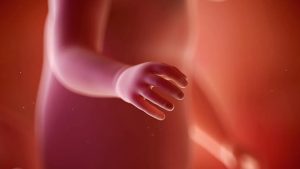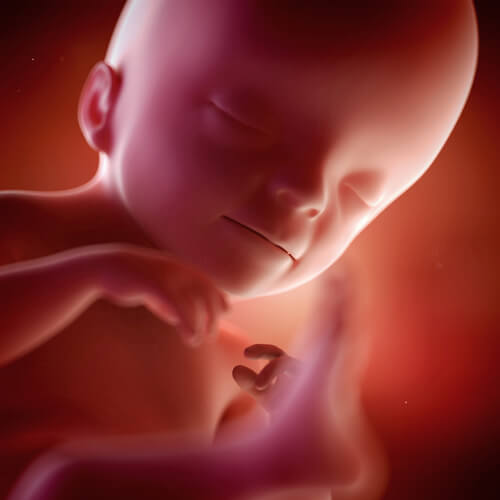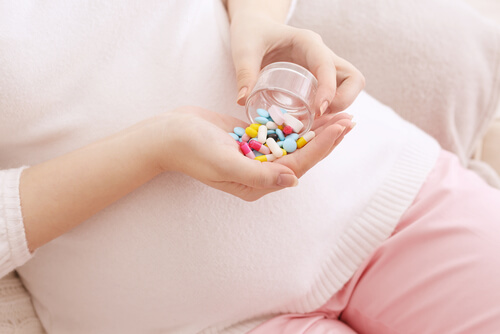The 21st Week of Pregnancy

In the 21st week of pregnancy, most pregnant women will be noticing their baby’s movements. He or she will now measure around 25 centimeters and weigh around 300 grams.
In addition, according to medical studies, the baby is already very active, moving 50 times every hour. These movements, some of them reflexes, are designed to stimulate their physical and mental development.
In addition, their developing brain will begin to pick up electrical signals from their body. These signals will be mainly related to sensations such as pressure, pain, light or temperature.
Evolution of the baby in the 21st week of pregnancy
At this stage the digestive system is starting to develop and mature. It allows the baby to swallow amniotic fluid and absorb some of its nutrients in the small intestine. The rest of the content will pass to the large intestine. However, he will still get most of the nutrients from the fluid that surrounds him.
In addition, the bone marrow is starting to make red blood cells. Up until now, this function was performed by the liver and spleen. Nails also begin to grow, although they haven’t hardened yet. This fact, together with the presence of the vermix – a waxy substance that covers the baby – prevents it from scratching and hurting itself.
In boys, the testes descend from the pelvis to the scrotum, while in girls the vagina begins to form. From the 21st week of pregnancy you can now find out the baby’s sex, if it’s well placed when the ultrasound is carried out.

Changes in the mother
We have good news, because at this stage of the pregnancy, the expectant mother usually feels a lot better. The organism has already adapted to the sudden hormonal changes. The typical discomforts of the first trimester have disappeared, and the discomfort and heaviness of the end of the pregnancy still haven’t arrived.
In week 21 the uterus continues to grow, and measures approximately 20 centimeters. This can lead to certain changes, which don’t necessarily affect all pregnant women in the same way:
- The muscles of the abdomen and the rectum can separate and produce diastasis of the rectum, which would appear as an elongated bulge in the center of the abdomen.
- Stretch marks may appear, as the skin is stretching to accommodate the growth of the uterus.
- It’s also possible that the belly button will pop outwards. This is usually temporary and it will return to its original position after birth.
- In addition, in this period there is a greater fluid retention and there will usually be more vaginal discharge than usual. These are usually clear and shouldn’t smell too strong. Apart from these secretions, there may be losses of urine when coughing or laughing, for example.
Advice and care for week 21
One of the best ways to reduce discomfort, stress and to sleep better, is to enjoy a good massage.
This is a good time to start taking vitamins. Following the advice of your doctor, you can take supplements and vitamins, such as vitamins C, D, or iron. Combined with a balanced and varied diet, they will provide the necessary nutrients to strengthen both the mother and the baby.
If the appearance of stretch marks is a concern, you can try to fight against them. To do this, it is advisable to keep the skin hydrated and consume foods rich in vitamins A, C and E. These nutrients are necessary for the synthesis of collagen in the skin.

Finally, one of the best ways to reduce discomfort, stress and to sleep better, is to enjoy a good massage. In addition to relaxing you, and relieving the discomforts of pregnancy, it will stimulate circulation.
Pregnancy control: morphology ultrasound
If it hasn’t been done before, week 21 is the time to perform the morphology ultrasound. In this process, in addition to taking the measurements of the baby, a detailed examination of his or her morphology is carried out.
With this ultrasound, you can see if there are any abnormalities in the development of the fetus. This way, possible malformations could be diagnosed, and doctors will see whether it is necessary to carry out more tests. These may include more ultrasounds, blood or urine tests, amniocentesis, or magnetic resonance, for example.
The morphology ultrasound is of great importance because it enables a very early detection of anomalies. Thanks to medical advances, it’s possible to treat and even solve some of these problems.
In some cases the solution is a change in diet or medication and nutritional supplements. However, in others it will be necessary to resort to prenatal surgery, and this diagnostic ultrasound is vital in order to assist in this.
All cited sources were thoroughly reviewed by our team to ensure their quality, reliability, currency, and validity. The bibliography of this article was considered reliable and of academic or scientific accuracy.
- Calderón, Daniela Sequeira, et al. “Lumbalgia en el embarazo: abordaje para el médico general.” Revista Clínica de la Escuela de Medicina de la Universidad de Costa Rica 9.5 (2019): 34-38.
- Martín-Martín, Sergio, et al. “Incontinencia urinaria en embarazo y postparto. Factores de riesgo asociados e influencia de los ejercicios del suelo pélvico.” Archivos españoles de urología 67.4 (2014): 323-330.
- Parra-Saavedra, Miguel, et al. “Amniocentesis: guía práctica.” Diagnóstico Prenatal 25.1 (2014): 20-27.
- Lugones Botell, Miguel, and Miguel R. Sarduy Nápoles. “Amnesia en el embarazo.” Revista Cubana de Obstetricia y Ginecología 45.1 (2019): 137-146.
This text is provided for informational purposes only and does not replace consultation with a professional. If in doubt, consult your specialist.








